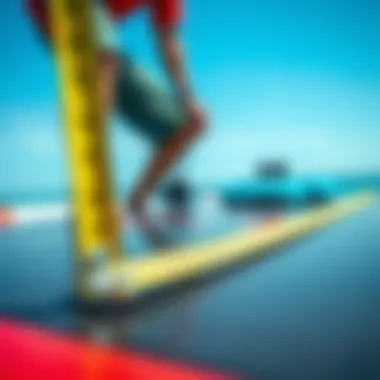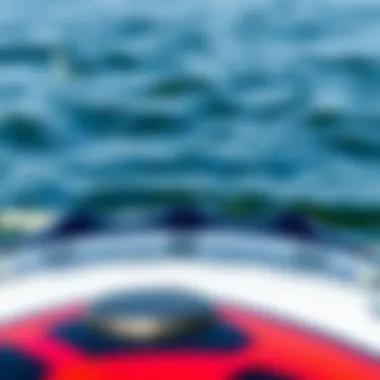How to Measure a Wakeboard for Optimal Performance


Intro
Understanding how to measure a wakeboard is a step that shouldn’t be overlooked by any enthusiast aiming to elevate their ride. The nuances of dimensions such as length, width, and rocker profile can dramatically transform the wakeboarding experience, making it either a smooth glide or a hair-raising ride. For anyone from beginners just starting to explore the waters to seasoned veterans honing their skills, this guide will shed light on making informed decisions about their gear.
In wakeboarding, every detail counts. It’s not just about buying the flashiest board on the market; it’s about choosing the one that fits your personal style and capabilities. The measurements significantly affect your performance on the water. For example, a shorter board might be more appropriate for tricks, while a longer board can provide stability for cruising. Knowing these intricacies helps you tailor your equipment properly.
Expert Insights
Latest Trends in Watersports
Watersports have seen considerable evolution over the years. A few trends are emerging that cater to the ever-growing audience of wakeboarders. One noticeable shift is the integration of eco-friendly materials in wakeboard construction. Manufacturers are increasingly utilizing sustainable resources without compromising performance. This not only appeals to environmentally conscious athletes but also enhances durability and responsiveness.
Another trend is the rise of tech-driven designs. Boards are being crafted with advanced hydrofoil technology to maximize lift and minimize drag. This results in more efficient rides and a unique appeal to those who seek innovation in their gear. Additionally, customization is gaining traction, as riders want their boards to reflect their style, leading to a market that supports bespoke board making.
Safety Protocols and Best Practices
Safety cannot be stressed enough when participating in wakeboarding. Here are some essential protocols:
- Wear a Life Jacket: This is non-negotiable. No matter how skilled you think you are, life jackets save lives.
- Check for Weather Conditions: Understand the weather before heading out. Strong winds or storms can create dangerous situations.
- Inspect Your Equipment: Before every ride, ensure your board, bindings, and rope are in good shape to prevent accidents.
Following these simple but effective practices can minimize risks and ensure an enjoyable day on the water.
Equipment Recommendations
Must-Have Gear for Beginners
If you’re just dipping your toes into wakeboarding, you don’t need to splurge on high-end equipment. Here are some essentials:
- Beginner Wakeboard: Look for something wide and stable; it will help with balance. Boards like the Hyperlite State are great for new riders.
- Bindings: Comfortable and adjustable bindings that allow for quick release can make things easier for starters.
- A Solid Rope with Handle: Make sure to get a rope made specifically for wakeboarding; it should be durable and the right length for your needs.
Advanced Equipment for Pros
For those who have mastered the basics and are looking to enhance their performance:
- High-Performance Wakeboard: Consider boards like the Ronix One. They offer great pop and responsiveness for tricks.
- Integrated Binding Systems: Boards with a built-in contour for bindings can enhance control when performing advanced maneuvers.
- Impact Vests: These provide protection from falls and add buoyancy without compromising movement.
The right equipment can make all the difference, whether you are just starting or pushing your limits in the sport.
Ending
In harmony with one’s skills and aspirations, the measurements and specifications of a wakeboard play a crucial role in determining performance and comfort. By taking the time to understand these elements, wakeboarders are better equipped to refine their equipment choices, leading to a more enjoyable experience. The tips outlined in this guide are meant to empower anyone, from the rookie to aficionado, ensuring that each ride is nothing short of exhilarating. For more in-depth discussions and community insights, consider checking out forums and reputable resources like Reddit and Wikipedia.
Knowing your board by understanding how to measure it can pave the way for memorable moments on the water.
Understanding the Basics of Wakeboarding
Wakeboarding, at its core, is more than just a thrilling sport; it's a dance on water. This engaging activity combines elements of surfing, snowboarding, and water skiing, resulting in an exhilarating experience for enthusiasts at all skill levels. But the allure of wakeboarding extends beyond adrenaline alone; understanding its basics lays the groundwork for elevating your performance and comfort on the water.
For both novices and seasoned riders, grasping the fundamentals of wakeboarding is essential. Knowing how the equipment works, especially the wakeboard itself, heavily influences riding capability. This knowledge ensures that the board you choose bears the right dimensions and characteristics tailored to your unique style and body.
The Appeal of Wakeboarding
Attracting a diverse range of athletes—from those seeking a casual day on the water to competitors chasing medals—wakeboarding holds widespread appeal. The sport invites a vibrant community where friendships flourish, and skills are honed. Riders often find joy not only in mastering tricks and jumps but also in the camaraderie shared during sessions with friends.
Key aspects to highlight about wakeboarding's appeal include:
- Versatility: Whether you’re carving gentle turns or launching high off the waves, there’s always a new challenge waiting.
- Accessibility: Many lakes, rivers, and coastal regions offer opportunities for wakeboarding, making it easier for some to access than snowboarding or surfing.
- Visual Splendor: There's a certain elegance in watching a rider glide across water, skillfully navigating through wakes.
The sensory experience of wakeboarding—feeling the wind, splashes of water, and the thrill of speed—draws individuals back time and again, making it more than just a sport; it’s a lifestyle.


The Role of Equipment in Performance
When it comes to wakeboarding, equipment pretty much makes the world go round. The wakeboard itself is the centerpiece of your ride, dictating how you maneuver and perform tricks. But the board's dimensions, shape, and additional features all carry weight in determining how well you do on the water.
The relationship between a rider and their board is intrinsic; mismatched equipment can lead to discomfort, or worse, injury. Here’s how your wakeboard specifics can affect your overall performance:
- Overall Length and Width: These dimensions impact stability, speed, and turning capabilities. A longer board aids in a smoother ride, while a shorter board heightens responsiveness.
- Rocker Profile: The board’s curvature, or rocker, determines how it rides over the water. Different shapes cater to various styles, from aggressive maneuvers to smooth cruising.
- Fin Configuration: Fins offer enhanced grip—too many can slow you down, while too few might make you feel unsteady. The right setup aligns with your riding style and conditions.
The comfort and safety of a rider hinge on their understanding of equipment functionality and the right measurements.
Thus, comprehending these elements not only leads to better performance but also allows riders to customize their setups to fit their individual style, making the experience both enjoyable and rewarding.
Key Measurements for Wakeboards
Understanding the measurements for wakeboards is crucial for anyone looking to enhance their experience out on the water. A wakeboard that fits properly not only provides better performance but also ensures a safer ride. The dimensions of a wakeboard, from its length to its width and rocker profile, significantly influence how it handles various riding styles and conditions. In this section, we will dive into key measurements that every wakeboarder should consider, breaking down each element and its importance.
Overall Length: Importance and Impact
The overall length of a wakeboard is one of the most significant factors to take into account. This measurement can range from about 130 cm to 170 cm, and the ideal length varies based on the rider's weight and skill level. A longer board tends to provide greater stability, particularly helpful for beginners who are still finding their footing. Conversely, shorter boards can offer more maneuverability, making them appealing for seasoned riders looking to perform tricks.
Choosing the right length plays a vital role in how the wakeboard reacts in different wake conditions. Too long, and you might feel sluggish; too short, and you could struggle with control. So, before you hit the water, ensure you’ve measured your wakeboard correctly in line with your physical attributes and preference. It’s one part science and another part art.
Width Considerations: Finding Balance
Width is equally critical in determining a wakeboard’s performance. A wider board provides more surface area, which translates to better buoyancy. This can be particularly beneficial for heavier riders or those who prefer to ride at lower speeds.
However, a wider board may sacrifice some agility. If you’re a rider who loves aggressive turns and flips, medium-width options might serve you better, offering a good balance between support and ply for tricks.
- Heavier riders: Should consider wider boards for better support.
- Performance riders: May opt for slimmer boards to enhance responsiveness.
Finding the correct width requires evaluating how you plan to ride while also taking your weight into account. Think of width as a balancing act: too much could weigh you down, while too little could leave you feeling unstable.
Rocker Profile: Types and Effects
The rocker profile indicates how curved the wakeboard is from tip to tail. Generally, there are three types of rocker profiles: continuous, three-stage, and hybrid.
- Continuous Rocker: Offers a smooth ride and helps maintain speed while reducing drag. Ideal for beginners.
- Three-Stage Rocker: Provides excellent vertical lift off the wake, favoring jumps and tricks. Good for advanced riders.
- Hybrid Rocker: Combines the two, giving riders the best of both worlds.
Each rocker profile serves different riding styles, impacting how you navigate the wake and perform tricks. A continuous rocker might not pop as high but will glide beautifully over water. In contrast, if your aim is to launch sky-high off the wake, a three-stage rocker is a sturdy choice.
Weight Capacity: Customizing for Safety
Weight capacity should never be overlooked when selecting a wakeboard. Each board comes with a recommended weight range, ensuring the best performance and safety. Riding a board outside of that capacity can seriously affect the board's responsiveness and potentially lead to accidents.
It's essential to not only consider your weight but also how much gear you might be carrying. For example, if you’re riding with a life vest or any extra accessories, add that weight to your calculations. Ensuring that the board you choose can handle your total weight is vital for an enjoyable and uneventful ride.
Fin Configuration: Tailoring Control
Finally, the fin configuration on a wakeboard can greatly affect how it tracks across the water. Fins increase stability, which can be crucial for beginners. Typically, boards come with removable fins, allowing riders to tailor their setup based on ability and riding style.
For beginners, a board with larger fins may provide that additional help with tracking straight. Advanced riders may prefer smaller or fewer fins to allow for more mobility and control when executing spins or tricks.
When it comes to fin configurations, it is wise to experiment until you find the setup that feels just right for your riding style. A little adjustment can go a long way in improving how you handle the board.
Tip: Don't hesitate to try out different configurations to see what works best for you; every rider has unique preferences.
Understanding these key measurements will enable riders to make informed decisions, enhancing their wakeboarding experience. The better tailored the wakeboard is to your personal specs, the more confidence you’ll exude on the water, regardless of your skill level.
Measuring Techniques


When it comes to wakeboarding, measurements play a pivotal role in shaping the overall experience on the water. From ensuring optimal performance to enhancing safety and comfort, having the right techniques for measuring your wakeboard can make all the difference. A precise measurement not only tailors the board to your specific needs but also allows you to maximize its extensive capabilities. By honing in on key measurements and employing effective techniques, you can forge a closer connection between you and your wakeboard.
Gathering Necessary Tools
Before diving into actual measurements, it’s essential to gather the right tools. Having the appropriate equipment can streamline the measuring process and reduce the chances for errors. Here’s what you'll generally need:
- Measuring tape (preferably a flexible one, such as a cloth or soft tape for better accuracy)
- Straight edge or ruler (to measure width accurately)
- Level (for checking rocker profiles)
- Weight scale (to determine weight capacity and rider suitability)
- Notebook or digital device for recording your findings
Having these tools on hand not only facilitates a smoother measuring process but also empowers you to make informed decisions based on concrete data.
Measuring Length: Step-by-Step
Measuring the length of your wakeboard is one of the foundational steps in ensuring it suits your riding style. Here’s a straightforward process to follow:
- Place the Wakeboard Flat: Lay the wakeboard on a flat surface, making sure there’s no obstruction beneath it.
- Align the Measuring Tape: Start measuring from the tip of the nose to the end of the tail.
- Record the Measurement: Keep the tape straight and record the total length.
- Double-check: It doesn’t hurt to measure again to confirm accuracy; after all, precision matters!
Measuring length affects gliding speed, control, and general maneuverability so it's worth doing right.
Width Measurement Methods
When it comes to width, it’s not merely about how broad the board is; it can influence stability, turns, and even your riding style. Here’s how to measure
- Identify the Widest Point: Flexing the wakeboard can create a slight curve, making it crucial to find the widest part. Usually, this is from edge to edge, at the center of the board.
- Use a Straight Edge: Place the straight edge across the widest point and measure from the edge of the board to the edge of the straight edge.
- Document the Measurement: Just like with the length, writing down your width measurement is vital for comparison and decision-making later.
Assessing the Rocker Profile
The rocker profile is crucial for determining how your wakeboard interacts with the water during rides. Here's how to properly assess it:
- Lay the Wakeboard Flat: Start with the board on an even surface.
- Use the Level Tool: Position the level across the midsection of your board. This will help indicate the curvature.
- Measure the Rise: The rise at the nose and tail should be noted. It dramatically affects turning and jumping.
Understanding the rocker profile helps you align your expectations and adjust your riding technique accordingly, ensuring you can adequately tackle various conditions.
Determining Weight Capacity Considerations
Weight capacity is a fundamental measurement that ensures your safety while maximizing performance. Here’s how to evaluate it:
- Check the Manufacturer's Specifications: Most companies usually provide maximum weight ratings for specific wakeboards. This is often found on the bottom of the board or in the user manual.
- Weigh Yourself or Your Gear: Consider any additional gear you may comprise or carry while riding.
- Account for Variability: Water conditions can also play a role. If you're a heavier set individual, perhaps you need a board that can manage weight better.
A wakeboard should never exceed the recommended weight capacity, as this affects its performance and can lead to hazardous situations.
Understanding and measuring for proper weight capacity boosts not just your riding confidence, but it also plays into overall safety on the water.
By using correct measuring techniques, wakeboarders can craft an optimized riding experience that serves their individual needs. Precision in measurement lays the groundwork for enjoyable learning curves, a safer adventure, and enhanced performance on the water.
Choosing the Right Wakeboard Size
Choosing the right size for your wakeboard can be the difference between an exhilarating day on the water and a frustrating one. This decision hinges on several critical elements such as your skill level, weight, and riding style. Each factor intertwines with the others to create a tailor-made experience, ensuring not just functionality but also enjoyment. Essentially, finding the right fit enhances performance, increases safety, and maximizes the overall thrill of wakeboarding.
Skill Level and Its Influence
Skill level is one of the foremost considerations when selecting a wakeboard size. As a novice, you might feel tempted to go for a smaller board, thinking it will be easier to control. However, a board that's too short could make it harder for you to gain stability as you learn the ropes. Conversely, experienced riders often prefer longer boards that offer more surface area for tricks and advanced maneuvers.
When you’re evaluating the board size, take into account how your skills influence the choice:
- Beginners might benefit from wider, longer boards, providing more stability while they find their footing.
- Intermediate riders tend to gravitate towards boards that offer a mix of stability and maneuverability, enabling them to experiment with different tricks.
- Advanced riders usually opt for shorter boards to facilitate sharper turns and high-speed tricks.
Rider Weight: A Critical Factor
Your weight plays a fundamental role in wakeboard sizing. Each board has a recommended weight range, and not adhering to this can lead to suboptimal performance. Too light for your chosen board? You might struggle to maintain control, making it a challenging ride. On the flip side, being heavier than the recommended range could result in the board sinking too deep in the water, diminishing its agility.


Here are some pointers to better grasp how weight impacts the choice:
- Lightweight riders should seek boards that are closer to the lower end of the recommended weight range.
- Those on the heavier side might want to consider boards that provide added support and buoyancy.
- If unsure about your weight category, it’s prudent to check specifications provided by manufacturers.
Riding Style: Personal Preferences Matter
Ultimately, personal riding style also bears a hefty weight in determining the right size for your board. Do you enjoy cruising on flat water, or are you more inclined toward aggressive tricks on the wake? Different riding styles may warrant different board dimensions. For example:
- Freestyle riders often favor shorter boards for easy spinning and quick maneuvers.
- Wakeboarders focusing on speed and performance might choose boards with a longer length, enhancing the potential for dynamic aerial tricks.
- Recreational riders generally gravitate toward boards that are comfortable and easy to manage, which can sometimes mean a more average size that suits multiple riding scenarios.
Thus, exploring various sizes and styles, and even trying them out can greatly influence your preference.
By considering skill level, weight, and personal riding style, your choice of a wakeboard size becomes not just a task but an enriching decision that enhances both your skills and enjoyment on the water.
Common Mistakes to Avoid in Measurements
Measuring a wakeboard may seem straightforward, but there are several pitfalls that even seasoned riders can fall into. Avoiding these common mistakes is crucial for ensuring that your gear aligns perfectly with your riding style and helps to prevent any avoidable mishaps.
Ignoring Manufacturer Guidelines
When diving into the technical side of wakeboard measurements, it's essential not to brush off the manufacturer's guidelines. These documents are crafted to provide insights based on rigorous testing, and they can significantly affect your board's performance. For instance, a manufacturer may recommend specific length and width ranges tailored to various skill levels.
Failure to pay attention to these recommendations can lead you down a slippery slope. If you're too lax with the guidelines, choosing a board outside the suitable parameters could lead to a handful of issues. Imagine opting for a longer board when you're quite the beginner; you might find it unwieldy, making your ride less enjoyable.
Moreover, these guidelines often include recommendations for weight capacity, which indicates how much load the wakeboard can handle safely. Straying from these specifications can result in decreased performance and even danger during your sessions. Always measure twice, cut once, as the old saying goes, and adhere to the reputable advice provided by the people who know the product best.
Neglecting Personal Riding Preferences
Another trap to watch out for is overlooking your personal riding preferences. Not everyone rides the same way, and that’s perfectly fine! Understanding what you enjoy can make a world of difference when it comes to selecting the right wakeboard. It's not always about sticking rigidly to measurements; your riding style can dictate your preferences.
For instance, if you relish the thrill of tricks and spins, you might want to lean towards a board that fosters agility rather than one that prioritizes stability. Conversely, those looking to cruise across smooth waters may favor a more balanced, wider board. In essence, your board choice reflects who you are as a rider.
When making your selection, consider your experience, preferred techniques, and even your average riding conditions. Discussing these details with experienced peers or coaches can lend valuable perspective. Statements like "I like to ride aggressively" serve better than a mere measurement when making the final decision.
Overlooking Safety Specifications
Safety specifications are often sidelined during the excitement of shopping for new gear, but they hold immense weight in the conversation of measurements. Failing to consider them can turn a fun day on the water into a risky venture.
One critical area to focus on is the weight capacity mentioned earlier. Overloading your board beyond what's specified not only affects performance but can also lead to injury. Each board comes with a clear indicator of its limits; honoring those numbers is paramount. Additionally, make sure to check strap designs and footbed sizes, as a poor fit can also lead to accidents—or at the very least an unpleasant riding experience.
Remember, safety specs aren’t just suggestions—they are there to ensure a good time on the water without a hitch. Read your board's details and take the time to see what it can safely handle. A cautious approach is always better to maintain the thrill without jeopardizing your safety.
"Safety first, fun second"
– A saying that all wakeboarders should live by.
In sum, careful measurement can yield positive outcomes. By steering clear of these frequent blunders—ignoring manufacturer guidelines, neglecting personal preferences, and overlooking safety specifications—you position yourself for more enjoyment, better rides, and a great experience on the water.
Final Thoughts on Measuring a Wakeboard
To wrap up our exploration into the measurements critical for wakeboarding, it’s essential to recognize how these details transform the riding experience. The technical aspects we’ve discussed neither exist in a vacuum nor are to be minor considerations, rather, they are integral to personalizing your ride and enhancing overall performance. Accurate measurements can mean the difference between a ride that feels like a dream and one that leaves you struggling to keep your balance.
The Importance of Accurate Measurements
When it comes to wakeboarding, the adage "measure twice, cut once" rings particularly true. Accurate measurements are not merely numbers; they’re the foundation of your interaction with the water. The connection between a well-measured wakeboard and the rider’s performance can’t be overstated. For example, if you choose a wakeboard that’s too wide, it could affect your ability to perform tricks or carve through the water smoothly. Conversely, if it’s too narrow, you may find yourself struggling with stability.
Through careful analysis of length, width, rocker profile, and fin configuration, riders can select a board that complements their capabilities and preferences.
“A board that fits you well is a key to unlocking your potential on the water.”
Moreover, failing to pay attention to size can lead to discomfort and even injuries in the long run. Not only do accurate measurements boost performance, but they also safeguard the rider’s well-being. Whether a novice looking to build confidence or an experienced rider pushing boundaries, understanding these dimensions is crucial.
Evolving with Your Equipment Needs
Every wakeboarder knows the thrill of the first ride. However, as time progresses, so do the needs and skills of the rider. Evolving with your equipment means taking stock of not just how your skills have transformed, but also how your preferences have shifted. A board that once felt just right may later seem inadequate as you advance in techniques or change your style of riding.
The significance of revisiting measurements can’t be overlooked. Regular assessments can lead to improvements and refinements in your choice of equipment. When you start feeling uncomfortable or unchallenged while riding, it’s time to evaluate if upgrading to a new board or altering your current one could enhance your experience.
Staying informed and adaptable is part of the journey—what works today might not be the best fit tomorrow. Remember to engage with communities, forums, and trusted resources, such as reddit.com/r/wakeboarding, to glean insights from fellow enthusiasts.







